
Cecelia Thorn The author has done extensive research.
Cooking with cannabis doesn’t need to be hard. When I first learned how to make edibles, it required some skill. But today, new kitchen gadgets like herbal infusers can make it much easier. That’s why I’m obsessed with my herbal infuser — and why I’m still obsessed with making homemade edibles, even when I’m short on time.
Read on to discover how to make cannabutter in a few simple steps.
What You’ll Need:
- Cannabis (either trim or bud)
- Coconut oil, olive oil, butter, or ghee. (Scroll down below these instructions to learn more about the benefits of each.)
- Glass jar (or, if you’re making a huge batch, a pyrex container works great)
- An herbal infuser like the Levo 2 or the HighPlant Herbability Infusion Machine
*The herbal infuser is optional, but highly recommended. (Scroll down for my first-hand LEVO 2 review.) If you don’t want to purchase one of these machines, you can still make your own edibles — it just requires a lot more effort. And a few more kitchen items.
What You’ll Need If You Don’t Buy an Herbal Infuser:
- The same starting materials listed above (cannabis, an oil or butter, and a container)
- A double boiler
- A baking sheet (for decarboxylating your cannabis in the oven before you start)**
- Some cheesecloth and a funnel (for straining)
**Most high-quality herbal infusers include a “decarb cycle,” but if you buy a cheaper herbal infuser like this one, you may still need to decarboxylate your cannabis in the oven, on a baking sheet.
Let’s get started!
To make cannabis edibles, you first need to make cannabutter (or canna-oil). Then it’s easy: You can add your cannabutter to any dish you make. Then, when your edibles take effect, you may face new challenges, like having a panic attack because you ate too much THC. (Scroll down for my method on how to avoid this, or at least how to make the best of it.)
Today, there are two main methods of making cannabutter. I love cooking with cannabis, and I used to do it the “old way” — I would make my cannabutter with a double boiler. Then, one day, I received a free LEVO 2 to test out. I loved it. (I immediately made it the top item in my guide to the best stoner gifts.) Now I can’t imagine going back to the laborious process of making cannabutter the old way.
But maybe you’re on a budget. Or you love spending time in the kitchen. If that’s the case, here are the instructions for how to make cannabutter the traditional way.
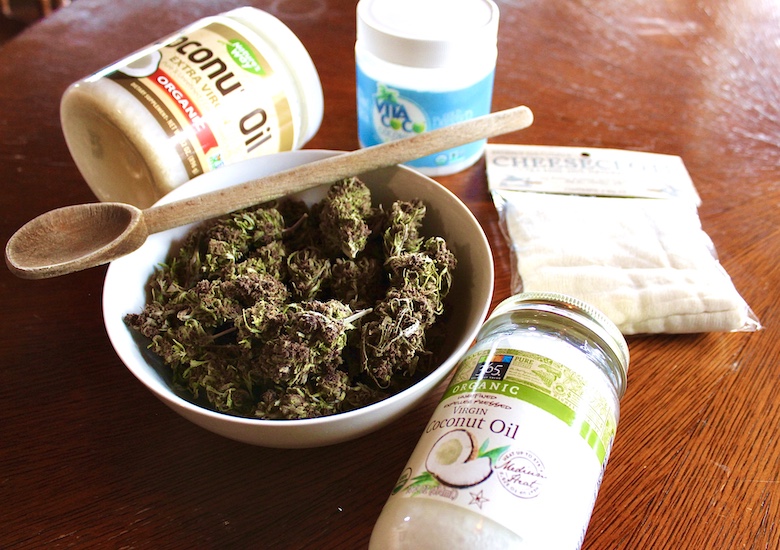
You don’t really need this many kinds of coconut oil.
How to Make Cannabutter
1. Prepare your herb for the decarboxylation phase.
If you’re using whole branches of cannabis (buds and stems and all), use scissors to cut it up into smaller pieces. If you’re using trim (the discarded leaves of the cannabis plant), just spread it out your baking sheet. There’s no special magic to this step. But some other websites will tell you to grind your herb before making cannabutter. However, most experts disagree. The trichomes you want are on the plant matter, not in it; grinding will not help you extract any more cannabinoids. (Grinding will, however, get more plant matter into your finished cannabutter, which could impart a more bitter flavor.) I never use a grinder when making edibles. I just break up the plant matter with my hands, and spread it out on the baking sheet. Some other websites will also tell you to use parchment paper. I’m sure it can’t hurt, but I’ve never needed parchment paper. Why would you? It’s not like the dried herb is going to get stuck to your baking sheet.
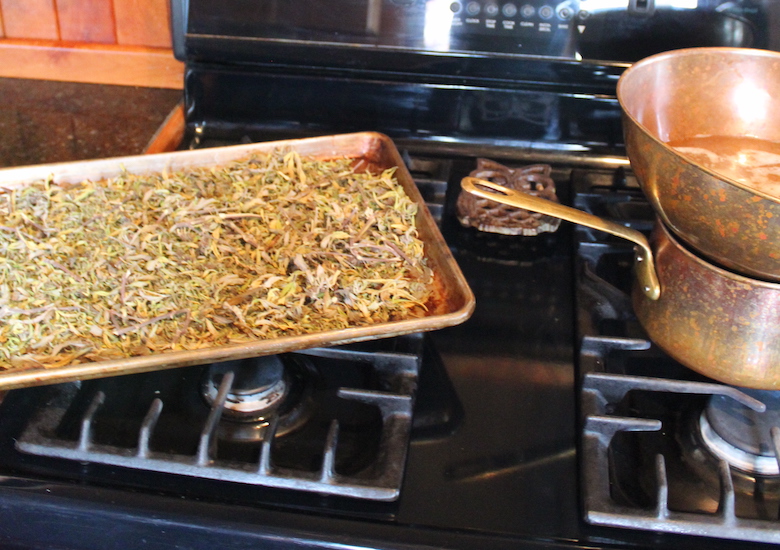
This cannabis decarboxylated just fine without any parchment paper.
How much herb should you use? That’s a tough question. Scroll down for my five main rules to enjoying your homemade edibles, where you’ll find that there’s no foolproof recipe to avoid overdoing it. A lot depends on whether you’re using trim or bud (or a mix of both), and how good the herb is. Was it grown outdoors with minimal effort, or indoors under the best LED grow lights for cannabis? Is it a high-THC strain or a high-CBD strain? Has it been stored in high-quality weed containers or in outdated plastic baggies? All these factors will influence the potency of your finished product.
But for general reference, if you use about 15 grams of plant material (trim, bud, and stems) in 1.5 cups of oil, one teaspoon of the resulting oil will be pretty darn strong. Like strong enough to induce some pretty deep sleep, if that’s what you’re after. But your tolerance (and your reaction) will be different. For another rough guideline, consider that the LEVO pod can fit about eight grams per about 2 cups of oil, and about one teaspoon of the resulting oil is potent, but it generally isn’t too strong for most people to handle. (For more dosing guidelines, and methods to figure out your tolerance, scroll down below this cannabutter recipe, where you’ll find my Five Rules for Cooking With Cannabis Without Freaking Out.)
2. Decarboxylate your herb.
If you skip this step, your edibles won’t have any effect. That’s because raw cannabis contains a molecule called THCA. THCA is similar to THC, except that our bodies can’t use it. But when THCA is exposed to heat (for example, when we smoke a joint, which requires combustion), the THCA is converted to THC, the molecule that gets you stoned. Want more of the science? Check out this Leafly article.
When you’re ready to decarboxylate, heat your oven to around 245 or 250 degrees Fahrenheit. Slide in your baking sheet, and let it decarb in the warm over for around 30 to 40 minutes, stirring the herb once or twice, while strong cannabis odors fill your home. Remember, you can also skip this whole step if you use a high-quality herbal infuser like a LEVO or a High Plant Herbability Infusion Machine, both of which will run a decarb cycle for you before infusing the oil.
3. Place some water in the bottom half of the double boiler, and your oil or butter in the top half.
If you don’t have a double boiler, you can place the water in a normal saucepan, then balance a non-plastic bowl above the water. (I used to make cannabutter this way, with a round-bottomed metal bowl balanced above a saucepan of water.) When you turn on the stovetop burner, the water will get hot, which will heat the oil. The oil won’t get burned, because it’s heated only by steam, not directly by the burner. (This is the genius of double boilers.) I’d usually use about two cups of water, but that’s not really important. You just want to make sure to have enough water in the lower pot so that it doesn’t burn off completely during the process, because then your butter or oil might get burned. You can check the lower pot at regular intervals, and add more water when needed.
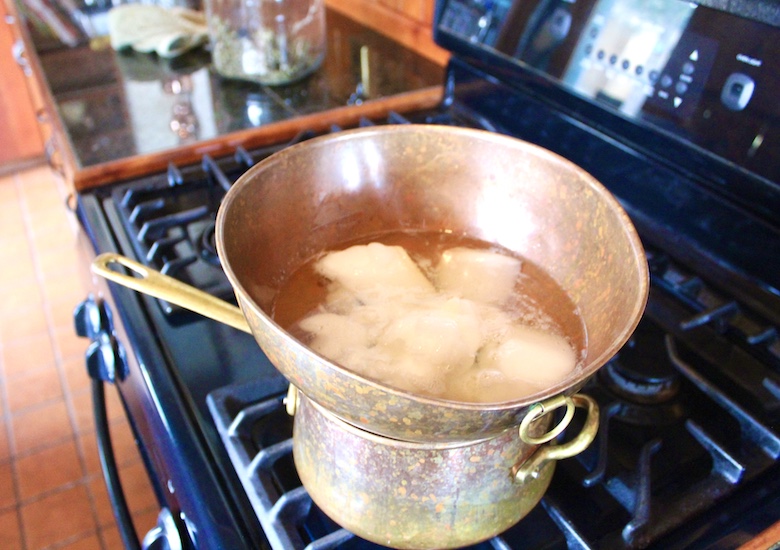
A makeshift double boiler. Place your oil or butter in the top half, while water simmers in the lower pot.
4. Add your decarboxylated herb to the melted oil in the upper pot.
Again, the amount is up to you. The resulting potency will depend on many factors. (Scroll down to learn more.) Make sure your herb is fully submerged in the melted butter or oil. If not, just add more oil until it’s submerged.
5. Wait at least one hour, while making sure the water in the lower pot doesn’t evaporate entirely.
I’ve always let my canna-oil infuse for at least two hours, usually more, with the burner on low heat. (And now when I use my LEVO 2 instead of the stovetop method, the LEVO’s standard cycle is also two hours. In my experience, this always seems to do a great job, though you can set it to run longer if you want.)
But when a food writer did an experiment with a cannabis testing lab, the lab concluded that over 80 percent of the cannabinoids had been infused into the oil after one hour. So if you’re not worried about squeezing every last cannabinoid out of your stash, you could probably stop after an hour. Then let your delicious oil cool off until you can handle it without burning yourself (but not so much that it hardens).
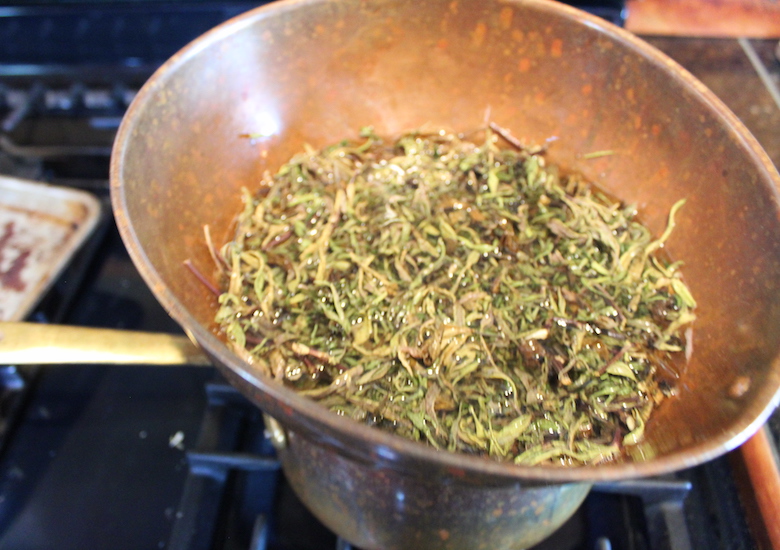
If your marijuana isn’t submerged, just add more oil (or butter).
6. Strain the cannabis from the finished oil.
I’ve always used cheesecloth for this step. It’s a bit tricky, especially if you’ve made a huge batch. One way to do it is to line a funnel or a mesh strainer with a large piece of cheesecloth, place it above your food-safe glass jar or pyrex container, and then slowly pour the oil from the pot into it.
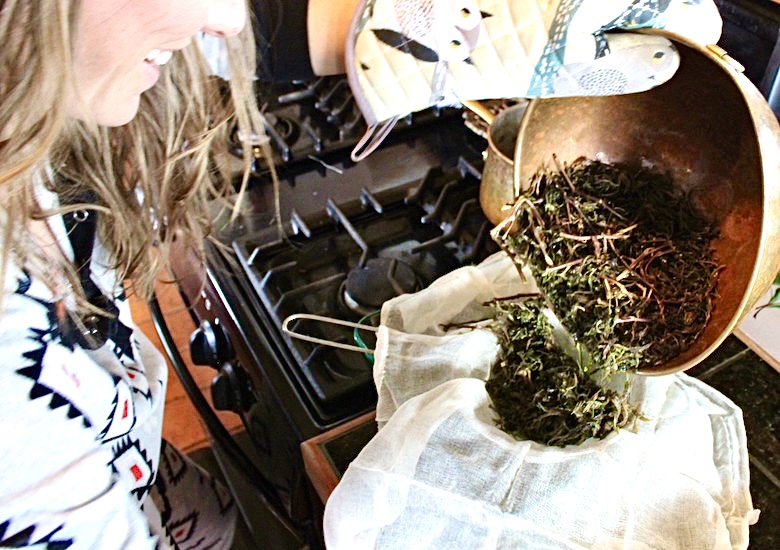
The cheesecloth will help you separate the plant material out of your finished cannabutter.
As you keep pouring, the cannabis will end up in the cheesecloth. Then you can wrap up the cheesecloth around it, as if you’ve made a giant teabag full of weed, and squeeze out the last drops of infused oil. Some people say that squeezing the cheesecloth will cause more of the cannabis flavor to end up in your finished oil, but I’ve never found that to be a huge problem.
(Remember, you can skip this step entirely by using an herbal infuser. When my LEVO 2 beeps to let me know the infusion cycle is complete, I simply press a button and watch a stream of infused oil flow into my glass jar.)
Yes, this is a lot of work. If you want to try edibles that will give you a buzz, but you live somewhere without access to dispensaries, you could also try HHC edibles. These aren’t as time-tested as THC edibles, but some users swear by them.
7. Clearly label your container.
Don’t skip this step. You need to make sure nobody else in your home uses your infused oil by accident. We recommend using a label maker to clearly label the jar or container. Of course, you could just use a sharpie, but a printed warning label will stand out more. Which is critically important. When someone eats a family member’s cannabutter by accident, they often end up calling 911 in a panic.
That’s why we’ve developed five rules for enjoying your homemade edibles.
Because when you make your own, they don’t come in convenient 10-milligram doses, the way most store-bought edibles do. These guidelines will not only help you make perfect, delicious edibles — they’ll also help you avoid spending the next several hours hiding under a pile of blankets, overanalyzing that thing you did that one time. (Or having an edibles-induced panic attack, which lands a surprising number of people in the emergency room every year.)
Read on to discover how to make your own edibles and enjoy the results, too.
Five Rules for Cooking With Cannabis — Without Freaking Out
1. You have to make your canna-butter first — but it doesn’t need to be butter. Olive oil and coconut oil work great, too.
I prefer to use coconut oil instead of butter. Virgin coconut oil is anti-microbial, so it lasts much longer than butter. It works great in baked goods as well as savory dishes. Coconut oil is solid at room temperature, so you can keep it in a glass jar on your kitchen counter, and spread it on anything you want, just like butter.
Obviously, butter is delicious, so we understand if you decide to use actual butter. Just keep in mind that your infused butter can grow mold in a matter of weeks, even when stored in an airtight container in the fridge. It’s disappointing to discover mold on your beautiful cannabutter and have to toss the whole batch.
Your infused coconut oil won’t get moldy. (Coconut oil has a shelf-life of about two years.) That’s why I like to start with organic cold-pressed coconut oil. You can make a huge batch, and cook with small amounts of that one batch for months to come. Read on to learn why using the same batch for a long time can be better than continually making fresh batches. (And no, it’s not just because stoners are lazy in the kitchen.)
2. You can add your cannabutter to almost anything you make, but there’s a reason why edibles are usually baked goods like cookies or brownies.
THC-infused pesto? Yes! High-dose casserole? I’ve made it!
But there’s a reason you’ve probably heard of “pot brownies,” and not “pot eggs benedict.” (And no, it’s not just because stoners always have the munchies and love brownies.)
When you mix your oil into batter or dough, you’ll know how much ends up in each cookie or brownie. Brownies are sliced and neatly divided in a way that pesto is not.
If you’re accustomed to eating large quantities of cannabis on a regular basis, you might be okay with haphazardly eating however much cannabutter ends up on your plate, and dealing with the results when they hit you. Otherwise, read on to learn why more uniformly-sized baked goods might be a good idea. (Equally-sized baked goods don’t have to be boring: This pot-leaf-shaped cookie cutter would ensure each cookie is the same size, while also alerting most adults to the cookies’ contents.)
3. There is no “correct” amount of cannabis to add, but there is a method for figuring out your ideal dosage.
When you’re learning how to make edibles, the trickiest part is the dosage. How much cannabis should you use when you’re making cannabutter? And then, once you’ve made your cannabutter or oil, how much of it should you add to your edibles?
Unfortunately, there’s no easy answer. Any article that promises to help you calculate the “correct” amount to add to your edibles is full of it. There are simply too many variables. Did you start with high-THC buds, or discarded trim? Was your cannabis fresh, or had it been sitting around in plastic bags for a while? How long did you let it steep in the oil? At what temperature? Did you decarboxylate the herb correctly first?
For more on decarboxylation, refer back to the instructions above for infusing your oil. Or just buy a LEVO 2 device, which includes an “activation cycle,” which will take care of decarboxylation for you.
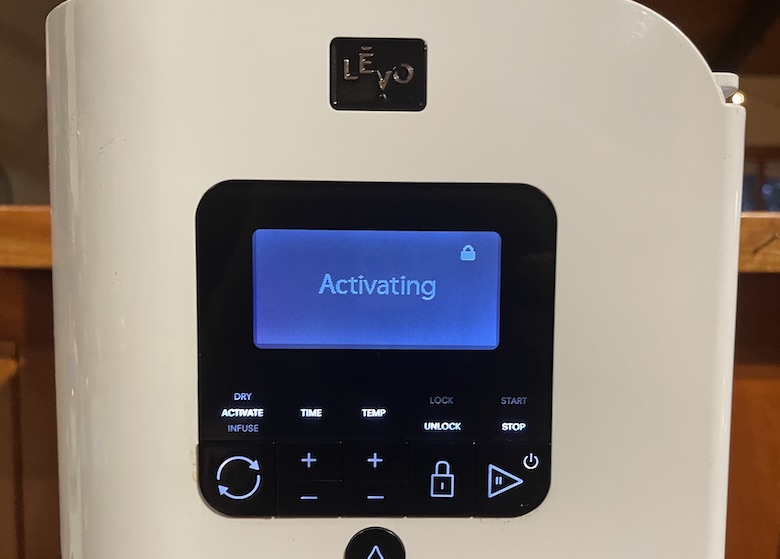
Pressing a button is a lot easier than the decarboxylation process described above.
And then, once you’ve cooked something with your cannabutter, more variables come into play. What’s your tolerance level? Did you just eat a huge meal, or are you eating your edibles on an empty stomach?
This article will provide some very general amounts in the how-to section below, but the right dosage is highly personal. You’ll need to experiment to figure out what works for you. The best way to do this is to make a large batch of oil, and then get to know that batch. Start small: Maybe you just smear a half-teaspoon onto some bread, on a day when you don’t have many big plans. Several hours later, you’ll know how your body responds to one half-teaspoon of this batch of oil. Then you can proceed from there, upping the dosage to figure out what works best for you.
This might seem like an overly cautious approach. But it’s much better than the alternative.
4. You really want to avoid over-eating THC. (Hello, anxiety!) But if you overdo it, and you handle it correctly, you will be okay.
Maybe you skipped that whole experimentation stage outlined above, and you ate too many edibles, and now you’re staring at the ceiling, worrying about that thing you said earlier, wondering if everyone hates you now.
Or even worse, maybe you ate too many edibles on a day when you really have to be somewhere. You have plans you can’t escape. Maybe you even have to go to work.
If this is you, call in sick. Right now. If at all possible, avoid going anywhere. If you have to deal with your overloaded cannabinoid receptors while out in public, it’s going to be so much harder. (And obviously, you shouldn’t be driving.)
On the flip side, you also don’t need to call 911. (Unless you’re experiencing a separate emergency.) You’d be surprised how many people freak out while high on edibles and call 911. The most notorious case was a police officer who had cooked up some edibles with confiscated marijuana, who then called 911 because he thought he was dying. But this officer isn’t alone: the trend appears to be growing. In Colorado, hospital emergency rooms saw a threefold increase in marijuana-related ER visits between 2012 and 2016.
In 2019, the Colorado Department of Public Health and Environment funded a study to look into these marijuana-induced ER visits. The researchers found stark differences between the ER patients who had smoked marijuana, versus those who had consumed edibles. The patients who had consumed edibles were far more likely to experience anxiety or panic attacks.
So even if you have a high tolerance for smoked marijuana, that doesn’t mean you have a high tolerance for ingested marijuana. Some scientists believe edible THC is processed differently by the liver, and converted into a compound with more potent psychiatric effects. Others believe this theory needs more research. It’s possible that when we eat edibles, we’re simply liable to consume too much THC at once. (It’s hard to smoke this much THC, because, at some point, you’d probably get too stoned to locate your lighter and pipe.)
But if you’re currently suffering from a THC-induced panic attack, you probably don’t care which molecule is causing it. If you’ve been googling for remedies, most articles will advise you to eat something. It’s not a bad suggestion — but you probably already thought of that. Now, the best thing to do is breathe. Remind yourself that you ate a potent edible, and the things you’re worrying about aren’t real (or at least, they aren’t as alarming as you currently imagine them to be).
(At least you haven’t eaten homegrown mushrooms — you would probably be freaking out even more right now.)
Remind yourself that nobody has ever died from a cannabis overdose. Drink some water. Go lay down. Falling asleep is a great option. Take a nap, if you can. Or just make yourself comfortable. You could consider some mindfulness meditation, where you try to watch your thoughts as they arise. When a worry surfaces, try to look closely: What are you really worried about? Is it really a problem? (Did it seem like a problem, before you got ultra-high?) Maybe you can fix it later, when you’re not super stoned. (That is, if you still think the Huge Problem is a Huge Problem, once your brain has returned to a normal state.)
As these thoughts continue to bounce around your brain, maybe you could label them “anxiety.” Sometimes it helps to name them. Remind yourself that you’re experiencing this anxiety because you ate a super-strong edible. Try to let it go. If you have access to some outdoor space, maybe go outside and look at the sky. However, if going outside means you have to talk to your neighbors, maybe skip it. (Any interactions with non-stoned people right now are likely to be awkward, and then you’ll spend a while thinking about the awkward interaction, which will only fuel your anxiety further.)
This is a great opportunity to write down how much of your canna-butter you ate. That way, you can make sure not to do it again.
Some experts suggest that taking CBD can help offset the anxiety induced by consuming too much THC. So you could try taking a CBD tincture, which generally enters the bloodstream faster than edible CBD. (You could also try taking a CBD oil capsule before eating your homemade edibles. Next time.)
Your brain might be doing some crazy cartwheels, and that’s okay. Remember: You’re going to be fine. No one has ever died from eating too much weed. What’s the worst that could happen? You have a terrible time, thinking unpleasant thoughts, and you decide to never eat edibles again. (Which would be a shame, because they really can help with deep sleep and relaxation.)
That said, if you are having a true psychiatric emergency, and believe you are a danger to yourself or others, you should obviously call 911 immediately.
But that’s highly unlikely. The best thing to do is find a place where you feel safe. If that means hiding under your blankets, that’s fine. Maybe you’ll fall asleep. Or just breathe. Either way, you’re going to be okay.
5. Just buy an herbal infuser, and start getting acquainted — slowly — with your own cannabutter.
This kitchen appliance will make your cannabis cooking journey a million times easier. The size of the metal “pod” — where you insert your cannabis buds or trim — limits the potency of your butter. It will still be plenty potent, but it’s less likely to land you in the emergency room in the throes of a panic attack.
When it’s easy to make your cannabutter, you won’t feel the need to go all in. Just make a batch of coconut oil, put it in an airtight jar, maybe with a notebook next to it. Then you can document how much you eat at once. (I’d start with a quarter teaspoon if you made your oil from bud, and maybe a half teaspoon if you made it with trim.)
Enjoy the journey!